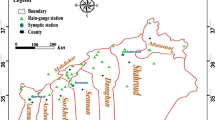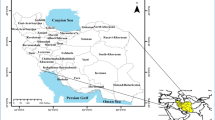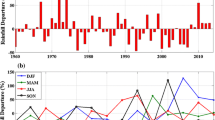Abstract
The drought has enormous adverse effects on agriculture, water resources and environment, and causes damages around the world. Drought risk assessment and prioritization of drought management can help decision makers and planners to manage the adverse effects of drought. This paper aims to determine the risk of drought in Iran. At the first stage, standardized precipitation index (SPI) was calculated for the period 1981–2016. Then the probability map of different drought classes or drought hazard probability map were prepared. After that the indicator-based vulnerability assessment method was used to determine the drought vulnerability index. Five indices including climate, topography, waterway density, land use and groundwater resources were chosen as the most critical factors of drought in Iran and followed by the analytical hierarchy process questionnaire, the weights of each index were obtained based on expert opinions. Fuzzy membership maps of each index and sub-index were prepared using ArcGIS software. The drought vulnerability map of Iran was plotted using these weights and maps of each indicator. Finally, the drought risk map of Iran was provided by multiplying drought hazard and vulnerability maps. According to the 43-completed questionnaires by experts, climate index has the highest vulnerability to drought. Climate does not have an important role in drought hazard index, but it is the most crucial factor to classified drought vulnerability index. The results showed that central, northeast, southeast and west parts of Iran are at high risks of drought. There are regions with different risks in Iran due to unusual weather and climatic conditions. We realized that the climate and the groundwater situation is almost the same in the central, east and south parts of Iran, because the land use plays a crucial role in the drought vulnerability and risk in these areas. The drought risk decreases from the center of Iran to the southwest and northwest.
Similar content being viewed by others
References
Ahmadalipour A, Moradkhani H, Castelletti A, et al. 2019. Future drought risk in Africa: Integrating vulnerability, climate change, and population growth. Science of the Total Environment, 662: 672–686.
Araya-Muñoz D, Metzger M J, Stuart N, et al. 2017. A spatial fuzzy logic approach to urban multi-hazard impact assessment in Concepción, Chile. Science of the Total Environment, 576: 508–519.
Ashok K R, Sasikala C. 2012. Farmers’ vulnerability to rainfall variability and technology adoption in rain-fed tank irrigated agriculture. Agricultural Economics Research Review, 25(2): 267–278.
Behrang M M, Khosravi H, Heydari A E, et al. 2019. Linkage of agricultural drought with meteorological drought in different climates of Iran. Theoretical and Applied Climatology, 138(1–2): 1025–1033.
Beven K, Almeida S, Aspinall W P, et al. 2018. Epistemic uncertainties and natural hazard risk assessment-Part 1: A review of different natural hazard areas. Natural Hazards and Earth System Sciences, 18(10): 2741–2768.
Birkmann J 2006. Measuring Vulnerability to Natural Hazards: Towards Disaster Resilient Societies. Tokyo: UNU Press, 1–720.
Bonham-Carter G F 1994. Geographic Information System for Geoscientists: Modeling with GIS. New York: Elsevier Science Ltd., 291–300.
Chen F, Jia H, Pan D 2019. Risk assessment of maize drought in China based on physical vulnerability. Journal of Food Quality, 1–9.
Dabanli I. 2018. Drought hazard, vulnerability, and risk assessment in Turkey. Arabian Journal of Geosciences, 11(18): 538.
Dai A. 2011. Drought under global warming: a review. Wiley Interdisciplinary Reviews: Climate Change, 2(1): 45–65.
Dayal K S, Deo R C, Apan A A. 2018. Spatio-temporal drought risk mapping approach and its application in the drought-prone region of south-east Queensland, Australia. Natural Hazards, 93(2): 823–847.
Dow K. 2010. News coverage of drought impacts and vulnerability in the US Carolinas, 1998–2007. Natural Hazards, 54(2): 497–518.
Downing T E, Olsthoorn A J, Tol R S J 1999. Climate, Change and Risk. London: Routledge, 1–18.
Downing T E, Bakker K. 2000. Drought discourse and vulnerability. Drought: A Global Assessment, 2: 213–230.
Dracup J A, Lee K S, Paulson E G. 1980. On the statistical characteristics of drought events. Water Resources Research, 16(2): 289–296.
Eakin H A, Bojórquez-Tapia L. 2001. Insights into the composition of household vulnerability from multi criteria decision analysis. Global Environmental Change, 18(1): 112–127.
Easter C. 1999. Small states development: a commonwealth vulnerability index. The Round Table, 88(351): 403–422.
Ekrami M, Marj A F, Barkhordari J, et al. 2016. Drought vulnerability mapping using AHP method in arid and semiarid areas: a case study for Taft Township, Yazd Province, Iran. Environmental Earth Sciences, 75(12): 1039.
Füssel H M. 2007. Vulnerability: A generally applicable conceptual framework for climate change research. Global Environmental Change, 17(2): 155–167.
Ghale Y A G, Altunkaynak A, Unal A. 2018. Investigation anthropogenic impacts and climate factors on drying up of Urmia Lake using water budget and drought analysis. Water Resources Management, 32(1): 325–337.
Han L, Zhang Q, Ma P, et al. 2016. The spatial distribution characteristics of a comprehensive drought risk index in southwestern China and underlying causes. Theoretical and Applied Climatology, 124(3–4): 517–528.
Hao L, Zhang X, Liu S. 2012. Risk assessment to China’s agricultural drought disaster in county unit. Natural Hazards, 61(2): 785–801.
He B, Lü A, Wu J, et al. 2011. Drought hazard assessment and spatial characteristics analysis in China. Journal of Geographical Sciences, 21(2): 235–249.
He B, Wu J, Lü A, et al. 2013. Quantitative assessment and spatial characteristic analysis of agricultural drought risk in China. Natural Hazards, 66(2): 155–166.
Heydari A E, Behrang M M, Khosravi H. 2018. Probability assessment of vegetation vulnerability to drought based on remote sensing data. Environmental Monitoring and Assessment, 190(12): 702.
Hill M J, Braaten R, Veitch S. et al. 2005. Multi-criteria decision analysis in spatial decision support: the ASSESS analytic hierarchy process and the role of quantitative methods and spatially explicit analysis. Environmental Modelling & Software, 20(7): 955–976.
Hinkel J. 2011. “Indicators of vulnerability and adaptive capacity”: towards a clarification of the science-policy interface. Global Environmental Change, 21(1): 198–208.
Hojjati M H, Boustani F. 2010. An assessment of groundwater crisis in Iran case study: Fars province. World Academy of Science, Engineering and Technology, 70: 476–480.
IPCC (Intergovernmental Panel on Climate Change) 2007. Climate Change: Impacts, Adaptation, and Vulnerability. Contribution of working group II to the fourth assessment report of the intergovernmental panel on climate change. Cambridge: Cambridge University Press, 1–987.
Izady A, Davary K, Alizadeh A, et al. 2012. Application of “panel-data” modeling to predict groundwater levels in the Neishaboor Plain, Iran. Hydrogeology Journal, 20(3): 435–447.
Jafary F, Bradley C. 2018. Groundwater irrigation management and the existing challenges from the farmers’ perspective in central Iran. Land, 7(1): 15.
Jain V K, Pandey R P, Jain M K. 2015. Spatio-temporal assessment of vulnerability to drought. Natural Hazards, 76(1): 443–469.
Jayanthi H, Husak G J, Funk C, et al. 2013. Modeling rain-fed maize vulnerability to droughts using the standardized precipitation index from satellite estimated rainfall—Southern Malawi case study. International Journal of Disaster Risk Reduction, 4: 71–81.
Jonkman S N, van Gelder P H A J M, Vrijling J K. 2003. An overview of quantitative risk measures for loss of life and economic damage. Journal of Hazardous Materials, 99(1): 1–30.
Jordaan A, Bahta Y T, Phatudi-Mphahlele B. 2019. Ecological vulnerability indicators to drought: Case of communal farmers in Eastern Cape, South Africa. Jàmbá: Journal of Disaster Risk Studies, 11(1): 591.
Karabulut M. 2015. Drought analysis in Antakya-Kahramanmaraş Graben, Turkey. Journal of Arid Land, 7(6): 741–754.
Khoshnodifar Z, Sookhtanlo M, Gholami H. 2012. Identification and measurement of indicators of drought vulnerability among wheat farmers in Mashhad County, Iran. Annals of Biological Research, 3(9): 4593–4600.
Khosravi H, Haydari E, Shekoohizadegan S, et al. 2017. Assessment the effect of drought on vegetation in desert area using landsat data. The Egyptian Journal of Remote Sensing and Space Science, 20(S1): S3–S12.
Kiem A S, Twomey C, Lockart N, et al. 2016. Links between East Coast Lows and the spatial and temporal variability of rainfall along the eastern seaboard of Australia. Journal of Southern Hemisphere Earth Systems Science, 66(2): 162–176.
Kim H, Park J, Yoo J, et al. 2015. Assessment of drought hazard, vulnerability, and risk: A case study for administrative districts in South Korea. Journal of Hydro-environment Research, 9(1): 28–35.
Knutson C, Hayes M, Phillips T 1998. How to Reduce Drought Risk. [2018-09-12]. http://drought.unl.edu/handbook/risk.pdf.
Lai C, Zhong R, Wang Z, et al. 2019. Monitoring hydrological drought using long-term satellite-based precipitation data. Science of the Total Environment, 649: 1198–1208.
Lee M, Pham H, Zhang X. 1999. A methodology for priority setting with application to software development process. European Journal of Operational Research, 118(2): 375–389.
Lei T, Wu J, Li X, et al 2016. A new framework for evaluating the impacts of drought on net primary productivity of grassland. Science of the Total Environment, 536; 161–172
Leichenko R M, O’brien K L. 2002. The dynamics of rural vulnerability to global change: the case of southern Africa. Mitigation and Adaptation Strategies for Global Change, 7(1): 1–18.
Lena D B, Vergni L, Antenucci F, et al. 2014. Analysis of drought in the region of Abruzzo (Central Italy) by the Standardized Precipitation Index. Theoretical and Applied Climatology, 115(1–2): 41–52.
Li C, Wang J, Yin S, et al. 2019. Drought hazard assessment and possible adaptation options for typical steppe grassland in Xilingol League, Inner Mongolia, China. Theoretical and Applied Climatology, 136(3–4): 1339–1346.
Liu Z, Zhang J, Luo H, et al. 2014. Temporal and spatial distribution of maize drought in Southwest of China based on agricultural reference index for drought. Transactions of the Chinese Society of Agricultural Engineering, 30(2): 105–115.
Malczewski J 1999. GIS and Multicriteria Decision Analysis. New York: John Wiley & Sons, 91–92.
McKee T B, Doesken N J, Kleist J 1993. The relationship of drought frequency and duration to time scales. In: Proceedings of the 8th Conference on Applied Climatology. Califonia: American Meteorological Society, 179–183.
Me-Bar Y, Valdez Jr F. 2005. On the vulnerability of the ancient Maya society to natural threats. Journal of Archaeological Science, 32(6): 813–825.
Mishra A K, Singh V P. 2010. A review of drought concepts. Journal of Hydrology, 391(1–2): 202–216.
Moghadasi N, Karimirad I, Sheikh V 2018. Assessing the impact of land use changes and rangelands and forest degradation on flooding using watershed modeling system. In: Do Carmo J S A. Natural Hazards - Risk Assessment and Vulnerability Reduction. [2019-03-21]. https://www.intechopen.com/books/natural-hazards-risk-assessment-and-vulnerability-reduction/assessing-the-impact-of-land-use-changes-and-rangelands-and-forest-degradation-on-flooding-using-wat/. doi: https://doi.org/10.5772/intechopen.77041.
Morid S, Moghaddasi M, Arshad S, et al 2005. Drought Index Package (Version 2). Tehran: Tarbiat Modares University, 23.
Mu Q, Zhao M, Kimball J S, et al. 2013. A remotely sensed global terrestrial drought severity index. Bulletin of the American Meteorological Society, 94(1): 83–98.
Muyambo F, Jordaan A J, Bahta Y T. 2017. Assessing social vulnerability to drought in South Africa: Policy implication for drought risk reduction. Jàmbá: Journal of Disaster Risk Studies, 9(1): 1–76.
Nasrollahi M, Khosravi H, Moghaddamnia A, et al. 2018. Assessment of drought risk index using drought hazard and vulnerability indices. Arabian Journal of Geosciences, 11(20): 606.
Nelson R, Kokic P, Elliston L, et al. 2005. Structural adjustment: a vulnerability index for Australian broadacre agriculture. Australian Commodities: Forecasts and Issues, 12(1): 171.
Orville H D. 1990. AMS statement on meteorological drought. Bulletin of the American Meteorological Society, 71(7): 1021–1025.
Popova Z, Ivanova M, Martins D, et al. 2014. Vulnerability of Bulgarian agriculture to drought and climate variability with focus on rainfed maize systems. Natural Hazards, 74(2): 865–886.
Potop V, Možný M, Soukup J. 2012. Drought evolution at various time scales in the lowland regions and their impact on vegetable crops in the Czech Republic. Agricultural and Forest Meteorology, 156: 121–133.
Rossi G, Benedini M, Tsakiris G, et al 1992. On regional drought estimation and analysis. Water Resources Management, 6(4), 249–277.
Sadeghravesh M H, Khosravi H, Ghasemian S. 2015. Application of fuzzy analytical hierarchy process for assessment of combating-desertification alternatives in central Iran. Natural Hazards, 75(1): 653–667.
Santos M J J, Verissimo R, Rodrigues R 2001. Overview of meteorological drought analysis on Western Europe. In: Assessment of the Regional Impact of Droughts in Europe. Technical Report 10. Lisbon: Water Institute, 78–79.
Shahid S, Behrawan H. 2008. Drought risk assessment in the western part of Bangladesh. Natural Hazards, 46(3): 391–413.
Sivakumar M V K, Wilhite D A 2002. Drought preparedness and drought management. [2018-09-12]. https://www.researchgate.net/publication/267362571_Drought_preparedness_and_drought_management
Skakun S, Kussul N, Shelestov A, et al. 2014. Flood hazard and flood risk assessment using a time series of satellite images: A case study in Namibia. Risk Analysis, 34(8): 1521–1537.
Sui D Z. 1992. A fuzzy GIS modeling approach for urban land evaluation. Computers, Environment and Urban Systems, 16(2): 101–115.
Tánago I G, Urquijo J, Blauhut V, et al. 2016. Learning from experience: a systematic review of assessments of vulnerability to drought. Natural Hazards, 80(2): 951–973.
Thomas T, Jaiswal R K, Galkate R, et al. 2016. Drought indicators-based integrated assessment of drought vulnerability: a case study of Bundelkhand droughts in central India. Natural Hazards, 81(3): 1627–1652.
Tonini F, Lasinio G J, Hochmair H H. 2012. Mapping return levels of absolute NDVI variations for the assessment of drought risk in Ethiopia. International Journal of Applied Earth Observation and Geoinformation, 18: 564–572.
Trenberth K E, Dai A, van der Schrier G, et al. (2014). Global warming and changes in drought. Nature Climate Change, 4(1): 17–22.
Vicente-Serrano S M, López-Moreno J I, Beguería S, et al. 2012. Accurate computation of a streamflow drought index. Journal of Hydrologic Engineering, 17(2): 318–332.
Vincent K 2004. Creating an index of social vulnerability to climate change in Africa. Tyndall Center for Climate Change Research Working Paper 56. [2018-09-12]. https://www.researchgate.net/publication/228809913_Creating_an_index_of_social_vulnerability_to_climate_change_for_Africa.
Wang M, Wang X, Huang W, et al 2012. Temporal and spatial distribution of seasonal drought in Southwest of China based on relative moisture index. Transactions of the Chinese Society of Agricultural Engineering, 28(19): 85–92. (in Chinese with English abstract)
Wang Z, Li J, Lai C, et al 2017. Does drought in China show a significant decreasing trend from 1961 to 2009? Science of The Total Environment, 579: 314–324.
Wilhite D A 2000. Drought as a natural hazard: concepts and definitions. In: Wilhite D A. Drought: A Global Assessment. London: Routledge, 3–18.
Wu Z, Mao Y, Li X, et al. 2016. Exploring spatiotemporal relationships among meteorological, agricultural, and hydrological droughts in Southwest China. Stochastic Environmental Research and Risk Assessment, 30(3): 1033–1044.
Yu X, He X, Zheng H, et al. 2014. Spatial and temporal analysis of drought risk during the crop-growing season over northeast China. Natural Hazards, 71(1): 275–289.
Zargar A, Sadiq R, Naser B, et al. 2011. A review of drought indices. Environmental Reviews, 19(NA): 333–349.
Zhang Q, Zhang J. 2016. Drought hazard assessment in typical corn cultivated areas of China at present and potential climate change. Natural Hazards, 81(2): 1323–1331.
Acknowledgements
We are grateful to the Faculty of Natural Resources, University of Tehran.
Author information
Authors and Affiliations
Corresponding author
Rights and permissions
About this article
Cite this article
Heydari Alamdarloo, E., Khosravi, H., Nasabpour, S. et al. Assessment of drought hazard, vulnerability and risk in Iran using GIS techniques. J. Arid Land 12, 984–1000 (2020). https://doi.org/10.1007/s40333-020-0096-4
Received:
Revised:
Accepted:
Published:
Issue Date:
DOI: https://doi.org/10.1007/s40333-020-0096-4




